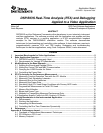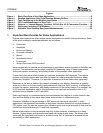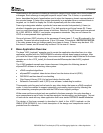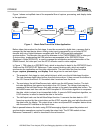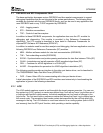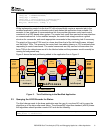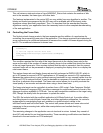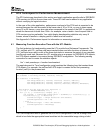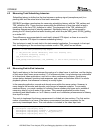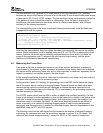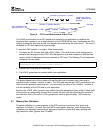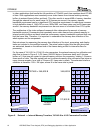
SPRAA56
DSP/BIOS Real-Time Analysis (RTA) and Debugging Applied to a Video Application 3
Quantization is the process of dividing a continuous range of input values into a finite number of
subranges. Each subrange is assigned a specific output value. The Q factor, or quantization
factor, describes the level of quantization used to store the frequency domain representation of
the encoded image. Q factor often varies dynamically in an encoder when a constant bitrate is
targeted, so it is useful to display the Q factor dynamically with the video stream.
Frame type designates whether a particular frame was encoded independently (I frame) or
whether it depends upon previous frames (P) or both previous and future frames (B). Frame
type is a useful benchmark when shown in real-time. Note that P and B frame types are relevant
for H.263, MPEG-4, MPEG-2, and similar compression standards. They are not relevant for
JPEG or uncompressed video applications.
Group-of-pictures (GOP) structure is the sequence of frame types (I, P, and B) produced by the
encoder. Common structure lengths are 12 and 15 frames. For example, IBBPBBPBBPBBPBB.
If the video stream does not change greatly from frame to frame, P frames may be about 10%
the size of I frames, and B frames may be about 2% the size of I frames.
2 Base Application Overview
The base "h263_loopback" example used to create the application described here is a video
application supplied with the TMS320DM642 evaluation module board support package. After
you install the board support package, the source code and included object libraries for the base
example are in the <CCS_install_dir>\boards\evmdm642\examples\video\h263_loopback
directory.
The H.263 loopback example was chosen because it integrates the following pieces of
eXpressDSP software in a working video system:
• xDAIS-compliant algorithms
• eXpressDSP-compliant video device drivers from the device driver kit (DDK)
• DSP/BIOS real-time kernel for scheduling
• Chip Support Library (CSL) for low level device function calls
• Reference Framework Level 5 (RF5) as a software / scheduling foundation
This example could be used as the basis for any video design that uses an xDAIS-compliant
codec. It could be modified to support networking or streaming input/output by following the
video networking examples provided with the EVM’s board support package.
While some real-time analysis tools are enabled in the base example, this note describes a
more comprehensive set of tools for real-time analysis, benchmarking, and debugging. This set
of tools can be used with any video application that has a similar DSP/BIOS-based foundation.
The design of the base example is described in detail in the H.263 Loopback on the
DM642 EVM (SPRA933), but a brief description of the design and components used is
provided here for reference.



